Logging is vital for tracking events, monitoring system health, troubleshooting issues, and ensuring security. It helps administrators maintain reliability and detect unauthorized access. Two popular tools can help you manage your logs: Fluentd and Logstash.
Fluentd offers flexibility and extensive plugin support, making it compatible with diverse data sources and destinations. Logstash, part of the Elastic Stack, excels in filtering, transforming, and enabling real-time log analysis and visualization.
If you’re wondering: “Which one should I use?” Then you’re in the right place! Explore the features, performance, and use cases of Fluentd and Logstash in this article to help you select the right tool.
|
Key Takeaways |
|
Overview of Fluentd and Logstash
Fluentd, developed by Treasure Data in 2011, is an open-source log collector that consolidates data from various sources into a centralized location. It’s widely used for real-time data processing and logging from servers and IoT devices.
Its flexibility and extensive plugin ecosystem, boasting over 500 plugins, make it highly compatible with cloud environments like Kubernetes. Its adaptable design and integration capabilities have contributed to its popularity.
Meanwhile, Elastic introduced Logstash in 2010 to integrate it with Kibana and Elasticsearch. Logstash also centralizes log data from various sources. With over 50 plugins, Logstash is well-suited for environments that utilize the Elastic Stack for data analysis and visualization.
As a CNCF project, Fluentd benefits from active community development, enhancing its efficiency in real-time data processing.
On the other hand, Logstash leverages the full power of the Elastic Stack to handle both structured and unstructured data. Often used with Beats for log collection, Logstash’s robust community support ensures continuous improvements, making it ideal for Elastic Stack environments.
Keep reading to learn more about Fluentd and Logstash.
Feature Comparison of Fluentd and Logstash
Fluentd and Logstash help collect and process logs but have different designs, features, and ecosystems. Knowing these differences is vital for choosing the right tool for your needs.
The table below highlights the main aspects of each tool, making it easier for you to decide based on your requirements:
|
Feature Comparison: Fluentd vs.Logstash |
||
|
Feature |
Fluentd |
Logstash |
|
Endorsing company |
Built and managed by Treasure Data and is a part of the CNCF |
A component of the well-known ELK stack that Elastic itself manages |
|
Language |
Written in C and Ruby, with no need for Java runtime dependencies |
Written in JRuby, hence requiring Java runtime on the host machine |
|
Platform |
Initially unavailable on Windows until 2015 Now runs on Windows |
Runs on both Windows and Linux Naturally cross-platform |
|
Ecosystem and Plugins |
Around 500 plugins |
Approximately 200 plugins |
|
Transport |
Provides an in-built buffering system configurable based on needs Can use in-memory or on-disk systems |
Does not support an in-built buffering system Limited to an in-memory queue holding up to 20 events (fixed) Relies on external queues like Redis or Kafka for consistency |
|
Performance |
More memory-efficient |
Consumes more memory than Fluentd |
|
Event routing |
Routes events based on tags |
Routes events based on if-else conditions |
Discover the key distinctions and unique strengths of these two popular log collector tools in a detailed feature comparison below.
Architecture
Fluentd and Logstash offer robust, flexible log management solutions, each with unique strengths. Fluentd is efficient and versatile, making it ideal for resource-constrained environments, while Logstash requires extensive plugins and Elastic Stack integration.
Here is a comparison of both tools’ architectures:
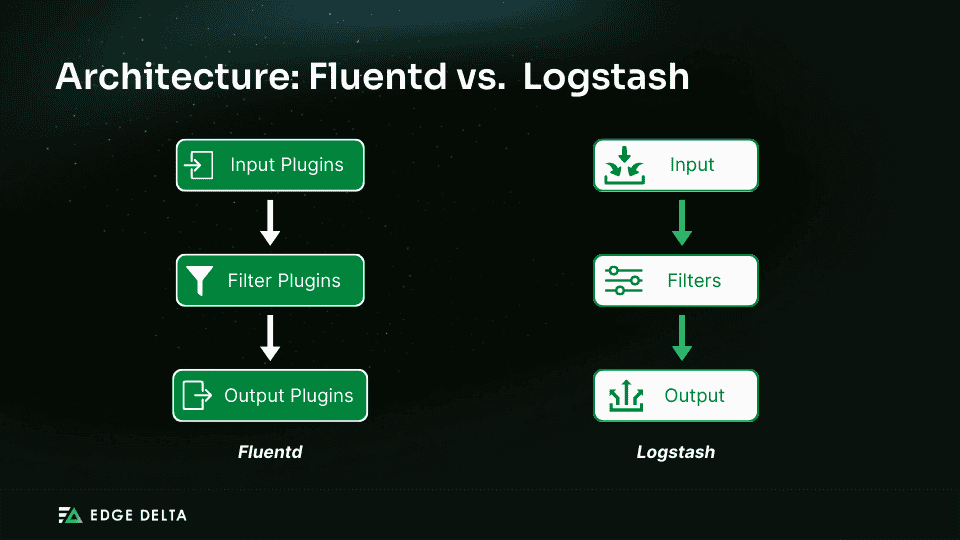
Fluentd
Fluentd uses a plugin-based architecture, which focuses on a lightweight and memory-efficient design ideal for resource-constrained environments. It consists of:
- Input plugins
- Filter plugins
- Output plugins
Input plugins collect data from sources like logs and databases. Filter plugins modify or enrich the data, while output plugins send it to destinations such as data lakes or analytics platforms.
Written in Ruby, Fluentd is designed for efficiency and uses advanced buffering mechanisms to ensure data reliability. Its unified logging layer provides a consistent interface for log collection, processing, and delivery across different systems, making it versatile for various environments.
Logstash
Logstash employs a flexible, plugin-based architecture composed of three main components:
- Inputs
- Filters
- Outputs
Inputs gather data from various sources, such as log files, databases, and message queues. Filters process, parse, enrich, and modify the data. Outputs send the processed data to destinations like Elasticsearch or files.
Logstash is written in Ruby but runs on the Java Virtual Machine (JVM), leveraging the JVM’s performance and cross-platform capabilities. It defines data pipelines using a declarative configuration file, making it adaptable and extensible with a wide range of plugins.
Here’s the architecture comparison table showing the differences between Fluentd vs. Logstash:
|
ARCHITECTURE COMPARISON |
||
|
Aspect |
Logstash |
Fluentd |
|
Core Components |
Inputs: Collect data from various sources |
Input Plugins: Collect data from various sources |
|
Filters: Transform, parse, enrich, and modify data |
Filter Plugins: Modify or enrich data before forwarding |
|
|
Outputs: Send processed data to various destinations |
Output Plugins: Send processed data to various destinations |
|
|
Design Principles |
Plugin-Based Architecture: Flexible system with modular plugins |
Plugin-Based Architecture: Modular system with customizable plugins |
|
Built on JVM: Written in Ruby but runs on Java Virtual Machine for cross-platform use |
Lightweight and Memory-Efficient: Written in Ruby, designed for efficiency |
|
|
Extensibility: Wide range of plugins for diverse data sources and destinations |
Buffering and Reliability: Sophisticated buffering for data reliability and backpressure |
|
|
Configuration: Declarative configuration file defines the data pipeline |
Unified Logging Layer: Consistent interface for log collection, processing, and delivery |
|
Plugin Ecosystem
Fluentd and Logstash have extensive plugin ecosystems that enhance their functionality by enabling data collection from various sources and output to numerous destinations. The main differences lie in the types of plugins available and how they are managed.
- Fluentd
Fluentd’s ecosystem is decentralized, with over 750 plugins developed and maintained by a community of contributors. This plugin ecosystem allows for high customization and flexibility. Fluentd offers eight types of plugins:
- Input Plugins: Collect data from sources like files, HTTP, and syslog (e.g.,
in_tail, in_http, in_syslog) - Parser Plugins: Structure incoming data into a readable format (e.g.,
parser_json, parser_regex) - Filter Plugins: Modify data before output (e.g.,
filter_grep, filter_record_transformer) - Output Plugins: Send data to various destinations (e.g.,
out_file, out_elasticsearch, out_s3) - Formatter Plugins: Format data before output (e.g.,
formatter_json, formatter_msgpack) - Storage Plugins: Manage log storage (e.g.,
buffer_file, buffer_memory) - Service Discovery Plugins: Discover services for log routing (e.g.,
sd_ec2, sd_dns) - Buffer Plugins: Buffer data before output (e.g.,
buffer_memory, buffer_file)
Despite the large number of plugins, the official repository hosts only 10—relying heavily on community contributions.
- Logstash
Logstash manages its plugins centrally, with 199 plugins in a single GitHub repository. This centralized management provides a unified and streamlined experience. Logstash offers four main types of plugins:
- Input Plugins: Collect data from various sources (e.g.,
log4j, beats, jdbc) - Filter Plugins: Process and transform data (e.g.,
grok, mutate, drop) - Output Plugins: Send data to different destinations (e.g.,
elasticsearch, stdout, kafka) - Codec Plugins: Encode or decode data during processing (e.g.,
json, plain, rubydebug)
Here’s a plugin comparison table:
|
PLUGIN COMPARISON |
||
|
Plugin Type |
Fluentd Plugins |
Logstash Plugins |
|
Input |
in_tail |
log4j |
|
Output |
out_file |
elasticsearch |
|
Filter |
filter_grep |
grok |
Performance and Scalability
Fluentd and Logstash are both excellent for managing logs. They have different strengths and weaknesses.
The former is efficient and uses fewer resources. Fluentd is lightweight and easy to scale. Conversely, Logstash can handle more logs but needs more memory and CPU power. Logstash is scalable, but it’s also more resource-intensive.
Below is a detailed discussion of the performance and scalability of Fluentd vs Logstash.
- Fluentd
- Efficient Event Buffering: Fluentd processes log data quickly with low delay due to advanced event buffering. This means it can quickly handle a lot of data while using fewer resources.
- Multi-threaded Architecture: The tool’s design enables it to process multiple log streams simultaneously, making it faster overall.
- Lower Resource Consumption: Fluentd is lightweight and works well in environments with limited memory, typically using about 40 MB of memory under load.
- Horizontal Scalability: It can run multiple instances together, distributing the work and improving reliability.
- Low CPU Usage: Fluentd processes large amounts of data with minimal CPU usage, making it good for resource-limited settings.
- Fluent Bit Integration: It uses Fluent Bit, a smaller version written in C, which further enhances its performance and scalability in limited resource scenarios.
- Logstash
- Resource-Intensive: Logstash demands more resources, especially in complex setups or high-volume environments. It uses the JVM, leading to higher memory use and possible performance slowdowns.
- Complex Data Transformations: The tool excels at complex data transformations but can slow down due to extra processing.
- Higher Memory Usage: Logstash consumes about 120 MB of memory on average, adding up in large-scale deployments.
- Horizontal Scalability: It scales horizontally by adding more instances. Due to resource demands, each instance may need more powerful machines.
- ElasticBeats Integration: Logstash works with ElasticBeats, a lightweight log shipper, helping reduce resource usage and improve scalability.
Here is the performance comparison graph for Fluentd and Logstash, showcasing their CPU and memory usage under load:
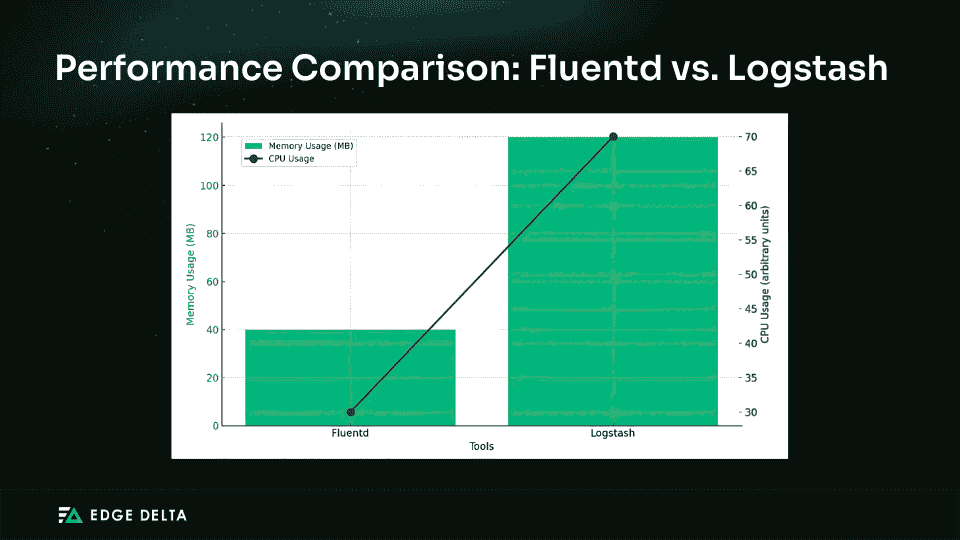
The graph above shows that Fluentd is more efficient in CPU and memory usage than Logstash. This data indicates that Fluentd is a better choice for high-volume data processing in memory-constrained environments.
Configuration and Ease of Use
When comparing Fluentd and Logstash, configuration complexity and ease of use are key factors. Each tool takes a different approach to setup and maintenance, which affects the preferences of users based on their needs and expertise.
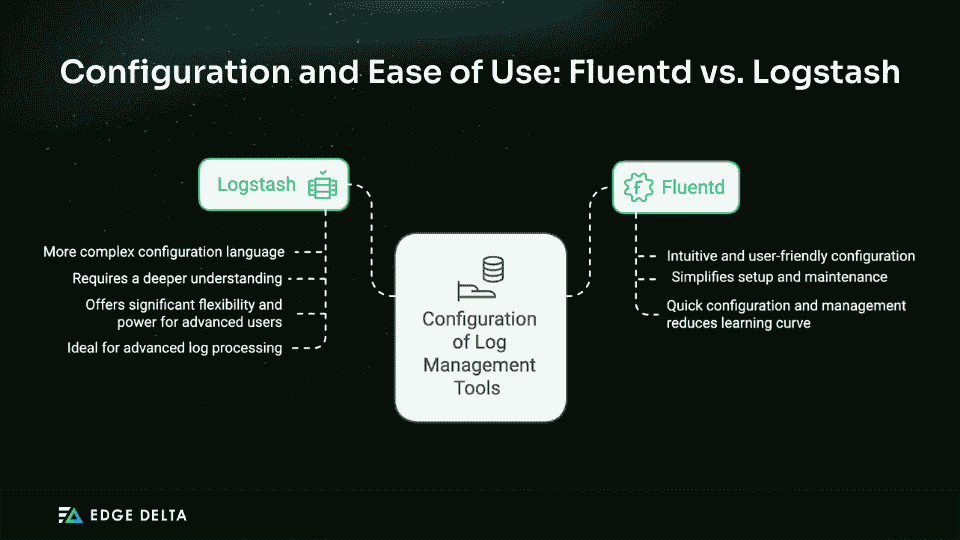
- Fluentd
- Offers intuitive and user-friendly configuration
- Simplifies setup and maintenance
- Reduces the learning curve, enabling quick configuration and management with minimal effort
- Logstash
- Has a more complex configuration language
- Requires a deeper understanding of internal workings
- Offers significant flexibility and power for advanced users
- Ideal for sophisticated log processing once the initial learning curve is overcome
Data Processing Capabilities
Fluentd and Logstash both handle data processing well but in different ways. Fluentd is convenient with its built-in parsers and plugins. Logstash offers more flexibility with its plugin-based setup. Choosing between them depends on your needs and how you prefer configuring and managing plugins.
Here is a table comparing their data processing capabilities with examples for each tool.
|
DATA PROCESSING EXAMPLES |
||
|
Task |
Fluentd |
Logstash |
|
Filtering |
|
|
|
Parsing |
|
|
|
Transformation |
|
|
Filtering
- Fluentd: Fluentd uses the <filter> directive and plugins like grep to filter log messages based on specific patterns, allowing for the inclusion or exclusion of messages using regular expressions.
- Logstash: Logstash employs filter blocks and plugins like mutate and drop to add tags or discard log messages based on defined conditions.
Parsing
- Fluentd: Fluentd includes built-in parsers like JSON, simplifying the parsing of structured log data. The @type directive specifies the parser type.
- Logstash: Logstash utilizes plugins such as JSON to parse log messages, allowing specification of the source and target fields for the parsed data.
Transformation
- Fluentd: Fluentd uses the record_transformer plugin to transform log data, enabling the addition, modification, or removal of fields in log records.
- Logstash: Logstash uses the mutate plugin to transform log data, allowing for field renaming, data type conversion, and other modifications.
Integration with Other Tools
Integration capabilities with various tools and platforms are crucial when choosing a log collection and processing tool. Fluentd and Logstash each offer unique integration strengths.
- Fluentd: Fluentd’s pluggable architecture supports over 500 community-contributed plugins, enabling quick integration with various data sources and outputs. Its extensive ecosystem makes it highly versatile for data integration.
- Logstash: Logstash excels in log processing and integrates seamlessly with Elasticsearch and Kibana. It leverages Java’s performance for efficient data processing and supports Linux, macOS, Windows, and Docker. Its flexibility and tight integration with the Elastic Stack make it ideal for comprehensive log management and analysis.
The table below lists common integrations for Fluentd and Logstash with various tools and platforms:
|
INTEGRATIONS |
|||
|
Tool1 |
Integration Type |
Fluentd |
Logstash |
|
Cloud Services |
Amazon Web Services (AWS) |
Supports AWS CloudWatch, S3, Kinesis, and more through plugins |
First-class integration with AWS services like CloudWatch |
|
Google Cloud Platform (GCP) |
Integrates with GCP services like Stackdriver, BigQuery, and Pub/Sub |
Integrates with GCP services, supports GCP Logging |
|
|
Microsoft Azure |
Integrates with Azure Blob Storage, Event Hubs, and Monitor |
Supports Azure Log Analytics |
|
|
Monitoring Systems |
Prometheus |
Integrates with Prometheus through plugins |
Supports Prometheus integration via community plugins |
|
Grafana |
Exports data to Grafana using plugins |
Integrates with Grafana for visualization |
|
|
Data Storage |
Elasticsearch |
Fully compatible, can send data to Elasticsearch |
First-class integration with Elasticsearch |
|
MongoDB |
Supports MongoDB through plugins |
Supports MongoDB integration |
|
|
Apache Kafka |
Integrates with Kafka for data streaming |
Supports Kafka as an input and output |
|
|
Log Management |
Splunk |
Supports Splunk through plugins |
Integrates with Splunk for log management |
|
Graylog |
Can forward data to Graylog |
Compatible with Graylog |
|
|
Other Integrations |
Docker |
Native support for Docker logging driver Integrates well with container environments |
Supports containerized deployment via Docker |
|
Kubernetes |
Integrates with Kubernetes for log collection and forwarding |
Supports Kubernetes logging |
|
Fluentd vs. Logstash: Performance Comparison
While Fluentd and Logstash share similar goals, their performance and efficiency can vary significantly based on use cases and system requirements. Understanding the nuances of their performance is crucial for selecting the right tool for your infrastructure.
Read on to learn more about the performance capabilities of Fluentd and Logstash.
Resource Utilization
|
Fluentd |
|
|
CPU Usage |
|
|
Memory Usage |
|
|
Logstash |
|
|
CPU Usage |
|
|
Memory Usage |
|
Here’s a resource usage graph for Fleuntd and Logstash that compares CPU and memory usage:
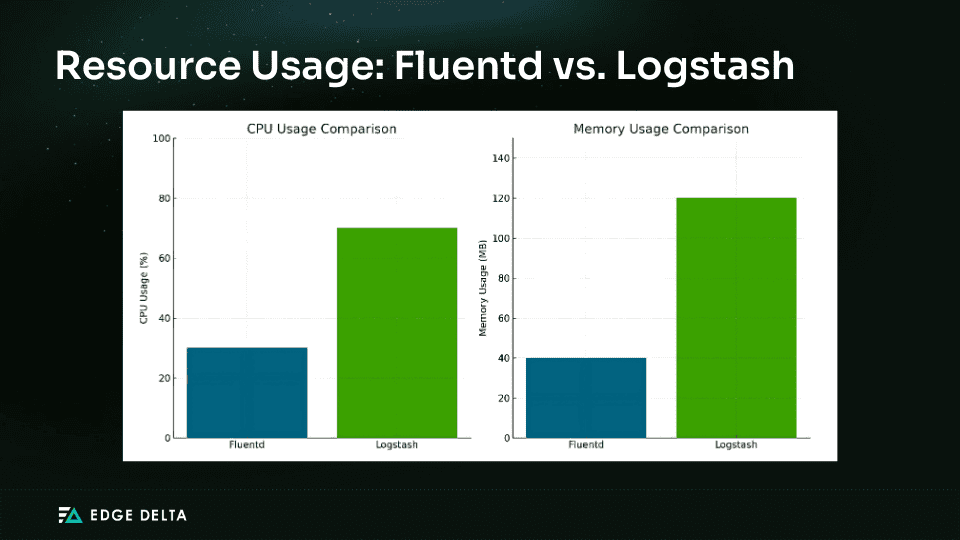
Throughput and Latency
Simple Ingestion
In simple ingestion scenarios, Fluentd tends to outperform Logstash in terms of throughput and latency due to its lightweight nature.
Fluentd
- Throughput: Fluentd can handle moderate log volumes efficiently due to its lightweight architecture. It achieves high throughput with minimal resource consumption.
- Latency: Fluentd offers low latency, quickly ingesting and forwarding logs to the destination (e.g., Elasticsearch). Its efficient buffering mechanism helps maintain low latency.
Logstash
- Throughput: Logstash handles moderate log volumes well but may consume more resources than Fluentd. Its plugin-based architecture provides flexibility but can affect throughput.
- Latency: Logstash typically has slightly higher latency than Fluentd due to its heavier processing engine and more complex pipeline configurations.
Complex Ingestion
Integrating customer data from CRM, sales data from ERP, and clickstream data from a website can be challenging due to the various formats and volumes of data involved.
Fluentd generally maintains better throughput and lower latency in complex ingestion scenarios due to its efficient architecture. However, depending on the specific requirements, Logstash’s powerful transformation capabilities may be advantageous.
Fluentd
- Throughput: Fluentd maintains good throughput when handling diverse data sources, benefiting from its efficient event-driven architecture. Its plugin ecosystem supports various input and output sources, but extensive transformations can slightly reduce throughput.
- Latency: Fluentd’s latency remains low even in complex scenarios—thanks to its buffering and chunking mechanisms that ensure smooth data flow.
Logstash
- Throughput: Logstash performs well in complex ingestion scenarios due to its powerful filtering and transformation capabilities. However, the more complex the pipeline, the more resources it requires, which can impact throughput.
- Latency: Logstash’s latency can increase with the complexity of the pipeline, mainly when multiple filters and transformations are applied.
Large-Scale Ingestion
Ingesting real-time data from millions of IoT devices in a smart city. Fluentd typically offers better throughput and lower latency in large-scale ingestion scenarios thanks to its scalability and efficient resource management.
- Fluentd
- Throughput: Fluentd is designed to scale horizontally, making it suitable for large-scale ingestion scenarios. By distributing the load across multiple nodes, it can efficiently handle high volumes of log data.
- Latency: Fluentd’s latency remains low even on large scales due to its asynchronous processing and robust buffering strategies.
- Logstash
- Throughput: Logstash can also handle large-scale ingestion, but it may require more resources to achieve a similar throughput as Fluentd. Its performance can be optimized with appropriate configurations, but it may not scale as seamlessly.
- Latency: Due to its synchronous processing model and complex pipeline execution, Logstash’s latency at a large scale can be higher than Fluentd’s, especially under heavy loads.
Check this out to know which tool is better in terms of throughput and latency performance across different ingestion scenarios:
|
THROUGHPUT AND LATENCY PERFORMANCE PER INGESTION SCENARIO |
|||
|
Criteria |
Simple Ingestion |
Complex Ingestion |
Large-Scale Ingestion |
|
Throughput |
Fluentd > Logstash |
Fluentd ≈ Logstash |
Fluentd > Logstash |
|
Latency |
Fluentd < Logstash |
Fluentd < Logstash |
Fluentd < Logstash |
The table below shows a comparative analysis of Fluentd and Logstash in various ingestion scenarios:
|
Ingestion Scenario |
Fluentd |
Logstash |
|
Simple Ingestion |
High throughput Low latency |
Good throughput Slightly higher latency due to pipeline overhead |
|
Complex Ingestion |
High throughput Increased latency with complex buffering and plugins |
Decreased throughput Significantly higher latency due to heavy processing load on the pipeline |
|
Large-Scale Ingestion |
Maintains high throughput Scalable buffering Slight latency increase with disk-based buffering |
Scalable throughput Requires careful resource allocation and tuning to manage latency effectively |
Scalability
- Fluentd
Fluentd is recognized for its lightweight and scalable architecture. Its design minimizes resource usage while efficiently handling a large volume of log data. Fluentd achieves this through efficient event buffering and batching mechanisms.
Scalability is primarily managed by running multiple Fluentd instances and setting them up to work seamlessly. This horizontal scalability guarantees Fluentd can handle increasing loads without significant performance degradation.
|
Fluentd Case Study One of Fluentd’s largest users, who gathers logs from over 50,000 servers, is a notable example of Fluentd’s scalability. This extensive deployment showcases Fluentd’s ability to manage massive volumes of log data in a distributed environment. The architecture’s efficiency in resource usage and its horizontal scalability ensure that Fluentd can handle such a significant load without performance issues, making it an excellent choice for large-scale log management. |
- Logstash
Logstash is designed to be horizontally scalable, meaning it can add more nodes running the same pipeline to handle varying throughput loads. This flexibility ensures that Logstash can manage different data flow levels by adding nodes as needed.
However, Logstash can be more resource-intensive than Fluentd (especially in high-volume environments). It uses the Java Virtual Machine (JVM) for processing, which can increase memory usage.
While it has adaptive buffering to manage variable loads smoothly, this can still require significant resources, and effective scaling may need careful optimization and additional hardware.
|
Logstash Case Study Logstash’s scalability shines in environments where adaptive buffering and horizontal scaling are essential. For example, a financial institution managing high-throughput log data has successfully scaled its Logstash deployment by adding more nodes to the pipeline. Despite the higher resource demands, they optimized their configuration to handle the load efficiently. This case study shows that Logstash can scale effectively in demanding environments with sufficient resources and proper optimization. |
Use Cases and Industry Adoption
Strong communities have adopted and supported Logstash and Fluentd, showcasing their adaptability and effectiveness in handling log data.
Logstash is a go-to choice within the Elastic Stack ecosystem, while Fluentd excels in cloud-native environments like Kubernetes. Their strong community support and adaptability meet diverse industry needs, from real-time data processing to platform integration.
Discover more about the use cases and industry adoption of both tools below.
1. Common Use Cases for Fluentd
Fluentd is a versatile data collector for log aggregation, monitoring, and analytics. It streamlines log management, making it easier to gather, process, and analyze log data from various sources.
- Log Aggregation: Fluentd collects logs from multiple sources, unifies them into a standard format, and routes them to a central location for quick access and analysis.
- Monitoring: Fluentd monitors logs in real-time, detecting anomalies and performance issues. It integrates with monitoring tools and dashboards to view system health comprehensively.
- Analytics: Fluentd transforms log data and forwards it to analytics platforms like Elasticsearch or Splunk, enabling detailed analysis and insights.
|
Fluentd Use Case: E-commerce Platform Logs A common use case for Fluentd involves processing logs from an e-commerce platform. Fluentd collects logs from microservices, web servers, and databases, treating each log entry as a separate event. It uses filters to extract critical information like transaction IDs, user activities, and error messages. Fluentd can enrich the data with details such as service names and environments. The logs are then sent to Elasticsearch for real-time search and analysis. This setup helps monitor user activity, identify performance issues, and detect security threats. Fluentd turns e-commerce platform logs into actionable insights, improving performance, ease of use, and security. |
2. Common Use Cases for Logstash
Logstash is commonly used in conjunction with Elasticsearch and Kibana to form the ELK stack, which provides a comprehensive solution for log management and analytics.
Here are some common use cases for Logstash:
- Log Aggregation: Logstash is commonly used to aggregate logs from various sources, including applications, servers, and network devices, into a centralized location. This centralization simplifies log management, improves accessibility, and enhances the ability to monitor and analyze logs for troubleshooting and operational insights.
- Security Analytics: Logstash plays a critical role in security analytics by collecting and processing logs from firewalls, intrusion detection systems, and other security devices. By parsing and enriching these logs, Logstash helps identify potential security threats and suspicious activities.
The processed data is then sent to Elasticsearch for real-time analysis and visualization in Kibana, enabling rapid detection and response to security incidents.
- Data Enrichment: Logstash enriches data by adding context to raw log entries. For example, it can append geolocation information to IP addresses or look up additional details from databases. This enrichment makes the data more valuable and easier to analyze, providing deeper insights into system operations and user behaviors.
- Real-Time Analytics: Logstash feeds data into Elasticsearch, enabling real-time analytics that can be visualized seamlessly in Kibana. This capability allows for live system monitoring, prompt issue response, and immediate insights into system performance and user activities.
|
Logstash Use Case: Processing Web Server Access Logs A common real-world use case for Logstash involves processing web server access logs. Logstash reads log files from web servers, treating each line as a separate event. It then uses patterns like Grok to extract useful information from these logs, such as status codes, request paths, and IP addresses. To enhance the data further, Logstash can add additional details, such as the geographic location of IP addresses. The enriched log data is then sent to a storage solution for real-time searching and analysis. This setup makes monitoring web traffic, identifying performance issues, and detecting security threats easy. In essence, Logstash gathers, processes, and enriches web server logs, transforming them into actionable insights for improving system performance and security. |
3. Industry Adoption
Fluentd and Logstash have become staples in the log management and data processing landscape. Each excels in different scenarios and is gaining wide acceptance across numerous industries. Their adoption by prominent companies and projects highlights their reliability and effectiveness.
- Fluentd: Fluentd’s lightweight architecture, ease of use, and flexibility make it a popular choice, especially in cloud-native environments.
Adoption Examples
|
Amazon Web Services (AWS): |
AWS uses Fluentd in its managed logging service, Amazon Kinesis Data Firehose, to ingest, transform, and deliver streaming data to AWS storage and analytics services. This integration helps AWS customers efficiently manage and analyze large volumes of log data. |
|
Google Cloud Platform (GCP) |
GCP leverages Fluentd in Google Kubernetes Engine (GKE) for centralized logging. Fluentd collects logs from Kubernetes clusters and routes them to Google Cloud Logging. This gives users a unified view of their cluster activities and simplifies log management. |
|
Treasure Data: |
As the creator of Fluentd, Treasure Data employs Fluentd extensively in its enterprise data management platform. Fluentd unifies log data from multiple sources, facilitating comprehensive data analytics and providing valuable insights for businesses. |
- Logstash: Logstash is widely adopted due to its robust data ingestion capabilities, extensive plugin ecosystem, and seamless integration with Elasticsearch and Kibana for log analysis and visualization.
Adoption Examples
- Netflix: Netflix uses Logstash as part of its centralized logging infrastructure to process and ship logs from various microservices to Elasticsearch, enabling real-time monitoring and analysis.
- Cisco: Cisco integrates Logstash into its security solutions to collect and process logs from network devices, enhancing threat detection and response capabilities.
- eBay: eBay employs Logstash to manage large volumes of log data from its e-commerce platform, facilitating efficient log analysis and monitoring.
Pros and Cons of Fluentd and Logstash
Understanding the pros and cons of Fluent and Logstash can help you choose the right tool for your specific needs. Explore Fluentd and Logstash’s pros and cons below to help you select a log management tool.
Pros and Cons of Fluentd
Evaluating the advantages and disadvantages of Fluentd can help you understand its suitability for different log management scenarios. The following is a comprehensive list of the key benefits and drawbacks of using Fluentd:
Advantages of Fluentd
- Source and Destination Agnostic: Fluentd can connect to any supported log source and destination by converting logs into standard JSON format.
- Rich Plugin Ecosystem: With over 600 plugins, Fluentd can easily integrate with various services.
- Stream Manipulation Capabilities: Fluentd supports log parsing, conversion, and data processing, allowing for custom log formats and advanced filtering.
- Lightweight: Fluentd requires only 40MB of RAM, with an even lighter version, Fluent Bit, using only 450KB.
- Good Cloud Integration: Fluentd integrates well with cloud services such as Amazon Kinesis and supports failover and load balancing for scalability.
- Tagging and Dynamic Routing: Fluentd uses tagging and routing without needing complex conditional logic.
- Failover and Load Balancing: Fluentd supports active-active and active-passive deployment patterns for availability and scalability.
Disadvantages of Fluentd
- Performance Issues: Fluentd’s plugin framework written in Ruby can limit speed, processing around 18,000 events per second on standard hardware.
- Installation and Setup: As an open-source product, Fluentd requires installation and configuration, which can be time-consuming.
- Intermediate Layer: Fluentd adds a layer between log sources and destinations, potentially causing delays and backups if event generation exceeds processing speed.
- Enterprise Support: Dedicated support is available only through Treasure Data, with community support being the primary option otherwise.
- Steep Learning Curve: Beginners may find Fluentd challenging to learn compared to alternatives like Logstash.
- Limited Transformation Capabilities: Fluentd’s data transformation features are less advanced than some competitors.
The table below summarizes Fluentd’s strengths and weaknesses, highlighting its versatility and performance considerations.
|
PROS AND CONS OF FLUENTD |
|
|
Pros |
Cons |
|
Source and Destination Agnostic |
Performance Issues |
|
Rich Plugin Ecosystem |
Installation and Setup |
|
Stream Manipulation Capabilities |
Intermediate Layer |
|
Lightweight |
Enterprise Support |
|
Good Cloud Integration |
Steep Learning Curve |
|
Tagging and Dynamic Routing |
Limited Transformation Capabilities |
|
Failover and Load Balancing |
– |
Pros and Cons of Logstash
Logstash is a powerful tool for processing log and event data. It has some great features, like being easy to use, having many plugins, and working well with Elasticsearch.
However, there are also some downsides. Logstash uses many resources, can be hard to set up for advanced tasks, and might slow down with heavy workloads. These pros and cons will help you decide if Logstash is right for your log management needs.
Advantages of Logstash
- Ease of Use: Logstash is relatively easy to set up and configure, especially if you know the ELK (Elasticsearch, Logstash, Kibana) stack.
- Rich Plugin Ecosystem: Logstash has many plugins for various data sources, filters, and outputs.
- Integration with Elasticsearch: Logstash integrates seamlessly with Elasticsearch, making it a good choice if you already use the ELK stack.
- Modern: Logstash allows configuration through a small webpage and REST API, enhancing its usability.
- Speed: Logstash configuration can be reloaded quickly, reflecting changes almost immediately.
- Configuration: Logstash is simple to configure with plaintext configuration files.
- Open Source: Logstash is open source and built with open-source tools.
Disadvantages of Logstash
- Resource Intensive: Logstash can be resource-intensive, especially when dealing with large volumes of data.
- Complex Configuration: Configuring Logstash for more complex data processing scenarios can be challenging for beginners.
- Performance: Some users report performance issues with Logstash under heavy workloads.
- Memory Usage: Logstash requires significant memory, needing at least 2GB even on commodity hardware.
- Conditional Routing Complexity: Logstash’s conditional syntax for routing content can become complicated.
- Interoperability Issues: You may need to write complex grok patterns to parse log data for which no plugin is available.
- Availability at Scale: Logstash’s Lumberjack protocol can cause performance bottlenecks during failover, and licensing may limit the solution’s deployment.
- Overlap: Logstash’s functionalities might overlap with other components if you start breaking the ELK stack.
The following table summarizes the key pros and cons of using Logstash:
|
PROS AND CONS OF LOGSTASH |
|
|
Advantages |
Disadvantages |
|
Easy to set up and configure |
Resource-intensive |
|
Wide range of plugins |
Challenging complex configurations |
|
Seamless Elasticsearch integration |
Performance issues under heavy loads |
|
Modern web and REST API configuration |
High memory usage |
|
Quick configuration reloads |
Complicated conditional routing |
|
Simple plaintext configuration |
Requires complex grok patterns |
|
Open source |
Bottlenecks during failover |
|
– |
Overlaps with other ELK components |
Choosing Between Fluentd and Logstash
When choosing between Fluentd and Logstash, several key factors must be evaluated. These log management tools offer special features and capabilities that can impact your logging infrastructure. Understanding the strengths and weaknesses of each option, from performance and scalability to usability and community support, is critical.
Read on to learn more about the important considerations and recommendations to help you make the best choice for your needs.
Factors to Consider
When deciding between Fluentd and Logstash for log management and data collection, it’s essential to evaluate various factors to ensure that the chosen tool aligns with your specific requirements. Here are key considerations to guide your decision:
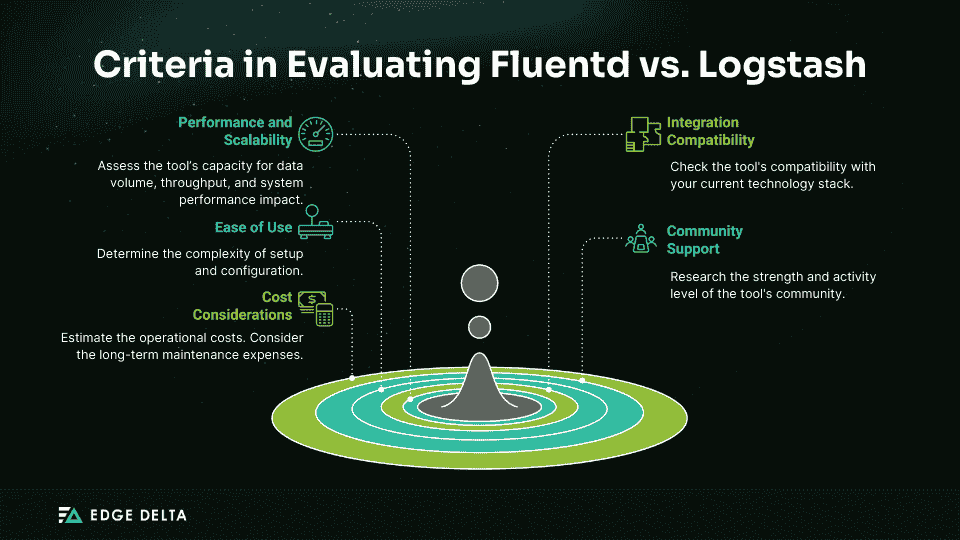
Recommendations Based on Use Cases
When choosing between Fluentd and Logstash for log management, consider the following key use cases and recommendations:
|
TOOL RECOMMENDATIONS BY USE CASE |
||
|
Use Case |
Recommended Tool |
Why? |
|
Simple log aggregation |
Fluentd |
Fluentd is lightweight and easy to set up, making it ideal for straightforward log aggregation tasks requiring minimal configuration and resource usage. |
|
Complex data transformations |
Logstash |
Logstash excels in scenarios requiring intricate data transformations with its robust filtering and parsing capabilities, allowing for detailed log data manipulation. |
|
Integration with Elastic Stack |
Logstash |
Logstash is natively compatible with Elasticsearch and integrates seamlessly with the Elastic Stack, making it the preferred choice for users already utilizing Elasticsearch. |
|
Cloud-based logging solutions |
Fluentd |
Fluentd is well-suited for cloud environments due to its lightweight nature and broad support for various cloud providers and services, offering flexibility and scalability. |
|
Lightweight logging solution |
Fluentd |
Fluentd’s low resource footprint makes it ideal for environments with limited resources. It ensures efficient log collection and forwarding without significant overhead. |
|
Customizable pipeline configuration |
Logstash |
Logstash provides extensive configuration options for building custom log processing pipelines, allowing for complex routing and transformation rules tailored to specific needs. |
|
High-performance data ingestion |
Fluentd |
Fluentd’s optimized architecture ensures high performance in data ingestion tasks, efficiently handling large volumes of log data and making it suitable for high-throughput environments. |
|
Real-time log analysis |
Logstash |
Logstash’s powerful processing capabilities enable it to perform on-the-fly data transformations and analytics, making it suitable for environments requiring immediate insights from log data. |
|
Kubernetes logging |
Fluentd |
Fluentd integrates well with Kubernetes, providing efficient log collection and forwarding for containerized applications, with support for various output destinations. |
|
Advanced filtering capabilities |
Logstash |
Logstash offers a rich set of filters that allow for detailed manipulation and advanced processing of log data, making it suitable for complex log analysis tasks. |
Conclusion
Fluentd and Logstash are both powerful tools for managing logs, each with unique advantages. Fluentd has a lightweight design and customizable plugins, perfect for efficient and scalable setups. On the other hand, Logstash excels in complex data transformations and works seamlessly with the Elastic Stack for a comprehensive data analysis system.
Choose Fluentd if you need flexibility and efficiency. Opt for Logstash if you need advanced processing and integration with the Elastic Stack. Evaluate your organization’s needs to decide which tool best fits your log management strategy.
FAQs for Fluentd vs Logstash
What is better than Logstash?
Fluentd is often preferred over Logstash for its flexibility, resource efficiency, ease of integration, and strong community support. It offers numerous plugins and uses fewer resources. However, other tools may be better, depending on your needs.
What are the disadvantages of Fluentd?
Fluentd’s disadvantages include limited performance due to its Ruby plugin framework, which handles about 18,000 events per second. Setup requires customization, and support is limited to Treasure Data customers. It introduces an intermediate layer, potentially slowing the logging pipeline and dropping events if buffering is exceeded.
Why is Fluentd better?
Fluentd excels due to its unified logging layer, allowing the use of logs as they are generated. This feature decouples data sources, enabling faster and more efficient data iteration. Additionally, Fluentd offers flexibility in collecting, filtering, buffering, and outputting data logs. Its widespread community support further enhances its reliability and effectiveness.
What is the purpose of Fluentd?
Fluentd is a unified logging layer separating data sources from backend systems. It allows developers and data analysts to use various types of logs as they are created efficiently. It also helps prevent “bad data” from causing slowdowns or misinformation. By providing this unified logging layer, Fluentd enables organizations to utilize data better and accelerate software development.
Sources






